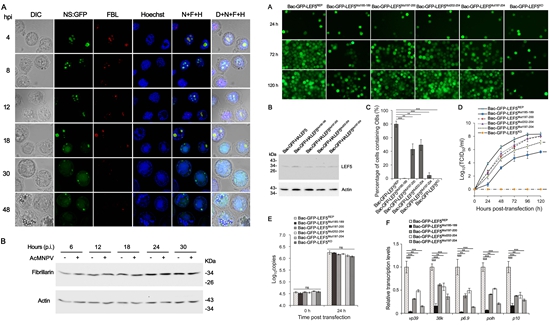Identification and Characterization of the Nucleolar Localization Signal of Autographa californica Multiple Nucleopolyhedrovirus LEF5
Many viruses, including human and plant viruses, target nucleolar functions as part of their infection strategy. However, nucleolar localization for baculovirus proteins has not yet been characterized.
Recently, researchers from China National Rice Research Institute report a functional analysis of the nucleolar dynamics during Autographa californica multiple nucleopolyhedrovirus (AcMNPV) infection. Through transcriptome analysis researchers identified two putative nucleolar proteins, Spodoptera frugiperda nucleostemin (SfNS) and fibrillarin (SfFBL) from Sf9 cells. Immunofluorescence analysis demonstrated that SfNS and SfFBL were localized to the nucleolus. AcMNPV infection resulted in reorganization of the nucleolus of infected cells.
AcMNPV late expression factor 5 (LEF5) is highly conserved in all sequenced baculovirus genomes and plays an important role in production of infectious viral progeny. In this study, nucleolar localization of AcMNPV LEF5 was characterized. Colocalization of LEF5 and SfNS showed that AcMNPV LEF5 was localized to the nucleolus in Sf9 cells. Bioinformatic analysis revealed that basic amino acids of LEF5 are enriched at residues 184 to 213 and may contain a nucleolar localization signal (NoLS). Green fluorescent protein (GFP) fused to NoLS of AcMNPV LEF5 localized to the nucleolus of transfected cells. Multiple point mutation analysis demonstrated that amino acid residues 197 to 204 are important for nucleolar localization of LEF5. To identify whether the NoLS in AcMNPV LEF5 is important for production of viral progeny, a lef5-null AcMNPV bacmid was constructed, several NoLS-mutated LEF5s were reinserted into the lef5-null AcMNPV bacmid with a GFP reporter. The constructs containing point mutations at residues 185 to 189 or 197 to 204 in AcMNPV LEF5 resulted in reduction in production of infectious viral progeny and occlusion body yield in bacmid-transfected cells. Together, these data suggested that AcMNPV LEF5 contains an NoLS, which is important for nucleolar localization of LEF5, progeny production and occlusion body production.
This research was supported by a National Natural Science Foundation of China (No. 31572006, 31701847 and 31972983), innovation project of the Chinese Academy of Agricultural Sciences and the Central Public-interest Scientific Institution Basal Research Fund (No. 2017RG002-7). The research findings have been published online in Journal of Virology on November 27 (DOI: 10.1128/JVI.01891-19). More details are available on the link below:
https://jvi.asm.org/content/jvi/early/2019/11/21/JVI.01891-19.full.pdf

By Chen Guoqing (chenguoqing@caas.cn)
-
 Apr 18, 2024Opening Ceremony of the Training Workshop on Wheat Head Scab Resistance Breeding and Pest Control in Africa Held in CAAS
Apr 18, 2024Opening Ceremony of the Training Workshop on Wheat Head Scab Resistance Breeding and Pest Control in Africa Held in CAAS -
 Apr 03, 2024IPPCAAS Co-organized the Training Workshop on Management and Application of Biopesticides in Nepal
Apr 03, 2024IPPCAAS Co-organized the Training Workshop on Management and Application of Biopesticides in Nepal -
 Mar 28, 2024Delegation from the School of Agriculture and Food Science of University College Dublin, Ireland Visit to IAS, CAAS
Mar 28, 2024Delegation from the School of Agriculture and Food Science of University College Dublin, Ireland Visit to IAS, CAAS -
 Mar 25, 2024Director of World Food Prize Foundation visited GSCAAS
Mar 25, 2024Director of World Food Prize Foundation visited GSCAAS -
 Mar 20, 2024Institute of Crop Sciences (ICS) and Syngenta Group Global Seeds Advance Collaborative Research in the Seed Industry
Mar 20, 2024Institute of Crop Sciences (ICS) and Syngenta Group Global Seeds Advance Collaborative Research in the Seed Industry
